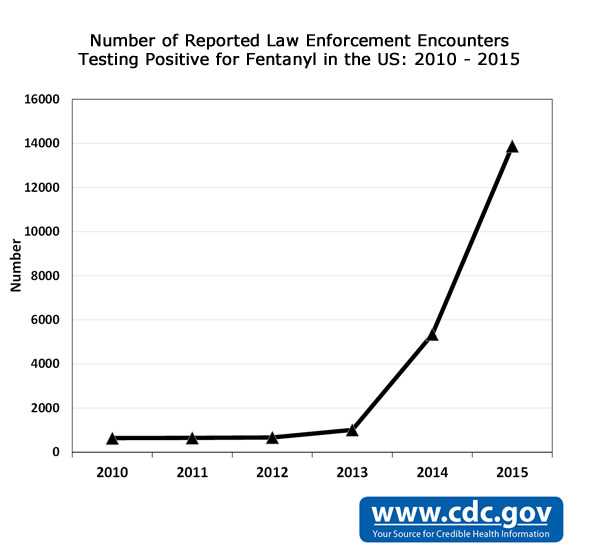Reported Law Enforcement Encounters Testing Positive for Fentanyl Increase Across US
Since 2013, law enforcement encounters (drug submitted for analysis) testing positive for fentanyl reported by laboratories participating in NFLISi has sharply increased in a growing number of states. A 2015 CDC Health Alert and 2016 MMWR documented states with high or increasing numbers of fentanyl encounters also reported increases in fentanyl-involved overdose deaths. Recent investigations in Ohio and Florida provide strong evidence of an association between reported fentanyl encounters and fentanyl-involved overdose deaths due to illicitly-made fentanyl.
Most of the increases in fentanyl deaths over the last three years do not involve prescription fentanyl but are related to illicitly-made fentanyl that is being mixed with or sold as heroin—with or without the users’ knowledge[i] and increasing as counterfeit pills.[ii] In July 2016, the Drug Enforcement Administration (DEA) issued a new nationwide report indicating hundreds of thousands of counterfeit prescription pills have been entering the U.S. drug market since 2014, some containing deadly amounts of fentanyl and fentanyl analogs.[ii] The current fentanyl crisis continues to expand in size and scope across the United States
The number of states reporting large numbers of fentanyl encounters substantially increased from 2014 to 2015, with 8 states reporting more than 500 encounters in 2015 compared to 2 states in 2014 and zero states in 2013. Data indicates:
- The number of fentanyl encounters more than doubled in the US from 5,343 in 2014 to 13,882 in 2015.
- 13 states reported that fentanyl encounters grew by 100 or more from 2014 to 2015, with rapid increases reported in the Northeast (New Hampshire and Massachusetts) and Midwest (Ohio) and with additional patterns developing in the South [Map: Change in Reported Law Enforcement Fentanyl Encounters 2014-2015].
- 2015 Rates of fentanyl encounters per 100,000 state residents identified states with higher levels of fentanyl supply per resident. Extremely high rates (>20) were found for Ohio, New Hampshire, and Massachusetts [Map: 2015 Fentanyl Encounters Rate].
- The steady increase in fentanyl encounters from 2013 to 2015 indicates that the supply of fentanyl, primarily illicitly-made fentanyl,ii continues to increase primarily east of the Mississippi with small increases west of the Mississippi.
For public health recommendations related to responding to increases in fentanyl-related overdoses and encounters, see CDC Health Alert.
Limitations: The analysis has the following limitations:
- Fentanyl drug report numbers and rates will vary across states and time periods due to differences and changes in law enforcement activity and percentage of drug cases submitted for laboratory testing.
- Ratios of fentanyl involved deaths to fentanyl encounters will vary substantially across states
- Fentanyl drug report rates may better capture changes in supply than numbers in smaller states.
- Fentanyl encounters do not distinguish between prescription fentanyl and illicitly-made fentanyl, but illicitly-made fentanyl has been reported as the primary driver for increases in both fentanyl encounters and fatal fentanyl-involved overdoses.ii

*This graph uses data from the DEA National Forensic Laboratory Information System (NFLIS) on the number of law enforcement drug submissions that test positive for fentanyl from 2014 to 2015 as of July 1, 2016.
Footnotes
[i] For additional information: DEA issues nationwide alert on fentanyl as threat to health and public safety, Counterfeit prescription pills containing fentanyls: A global threat, and Undetermined risk factors for fentanyl-related overdose deaths – Ohio, 2015 (EpiAid 2016-003).
[ii] For additional information: Counterfeit prescription pills containing fentanyls: A global threat.
- Page last reviewed: August 24, 2016
- Page last updated: August 24, 2016
- Content source:
- Centers for Disease Control and Prevention,
- National Center for Injury Prevention and Control,
- Division of Unintentional Injury Prevention


 ShareCompartir
ShareCompartir
